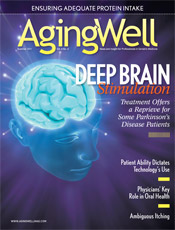
Summer 2011
Ensuring Adequate Protein IntakeBy Rachel Langendorfer, MSN, FNP-BC Healthcare professionals sometimes apply a one-size-fits-all approach to patients’ nutritional counseling. But in the case of protein, weight and age are factors that affect recommended daily intake. Protein stores throughout the body decrease naturally with age. These storage sites include skeletal muscle, red blood cells, white blood cells, platelets, hormones, and antibodies. Aging patients have a much higher rate of protein catabolism and a harder time utilizing proteins. This can create a protein deficiency known as a negative nitrogen balance. Every body system is affected by protein deficiency because proteins are essential for the body’s growth and repair. Additional types of proteins in the body are antibodies that protect against infection, hormones that relay messages, hemoglobin that transports oxygen through the bloodstream, and tendons and ligaments that provide a structural support. Protein Deficit Frailty is closely connected to decreased muscle mass and strength known as sarcopenia. With aging comes a decrease in the type 2 muscle fibers, which are much more powerful than the type 1 fibers. Thirty percent of muscle strength may be lost between the ages of 50 and 70.2 Additionally, poor protein intake weakens the immune response, making older patients more susceptible to infections and slowing the rate of wound healing.3 The recommended daily protein intake for patients up to the age of 55 is 0.8 g/kg of body weight. However, since muscle mass is lost much more rapidly with age, patients over the age of 55 need even more daily protein. Research has demonstrated that dietary protein must be 1 g/kg or more daily for older patients to prevent the loss of body protein stores.2 The additional stress of illness and injury causes an increase in protein breakdown and therefore increased nutritional requirements. No specific formula has been developed to determine how much protein a hospitalized older patient should consume, but it has been shown that even 1 g/kg is insufficient when the body is repairing itself and under stress from injury or sickness. Some studies have suggested a protein intake of 1.3 to 1.6 g/kg for this population.4 Generally, the hospitalized patient is unable to take in the additional protein through diet alone. Indeed, as many as 60% of older hospitalized patients may be malnourished on admission.4 Oral protein supplementation has a place in the hospital setting, as it has been proven to reduce the risk of pressure ulcer development in older adults.5 Alternate forms of protein supplementation, such as enteral or parenteral feeding, frequently become necessary. Intravenously administered essential amino acids are metabolized somewhat differently from proteins that pass through the digestive tract; however, they do travel to the skeletal muscle and increase muscle protein anabolism.2 Physicians’ Role as Educators Animal sources of proteins include poultry, fish, beef, pork, shellfish, eggs, milk, and milk products. These are all complete proteins. Because many older patients experience a decreased appetite as they age, consuming enough protein can become even more challenging. Some patients attempt to gain additional calories and protein through nutritional shakes. However, many older patients do not find these to be palatable options. Homemade foods may be a more enjoyable alternative. Share the following suggestions with your patients and their caregivers: • Make a high-protein milkshake by blending ice cream, milk, nonfat dry milk, and flavorings. Mixing in 2 tablespoons of peanut butter will add an extra 8 g of protein. • Prepare puddings, custards, and quiches, which are all packed with protein from milk products and eggs and are economical as well. • Purchase whole wheat bread with seeds to increase both protein and fiber intake. • Prepare a hearty stew or soup with lean beef and dried beans for a healthful and enjoyable meal in cooler weather. • Eat 1/2 cup of cottage cheese with fruit. • Consume a cup of Greek yogurt, which contains more protein than regular yogurt. Age-related body changes pose challenges to older patients and increase the risk of complications when protein intake is insufficient. Although decreased muscle mass and strength are inevitable in aging, the complications of falls, fractures, and impaired mobility are preventable. Through creative diet planning, your patients can fulfill the increased protein requirements necessary for better health. — Rachel Langendorfer, MSN, FNP-BC, is a certified family nurse practitioner at a family medicine practice in Greenville, S.C.
References 2. Dreyer HC, Volpi E. Role of protein and amino acids in the pathophysiology and treatment of sarcopenia. J Am Coll Nutr. 2005;24(2):140S-145S. 3. Chernoff R. Protein and older adults. J Am Coll Nutr. 2004;23(Suppl 6):627S-630S. 4. Gaillard C, Alix E, Boirie Y, Berrut G, Ritz P. Are elderly hospitalized patients getting enough protein? J Am Geriatr Soc. 2008;56(6):1045-1049. 5. Bourdel-Marchasson I, Barateau M, Rondeau V, et al. A multi-center trial of the effects of oral nutritional supplementation in critically ill older inpatients. Nutrition. 2000;16(1):1-5. |
